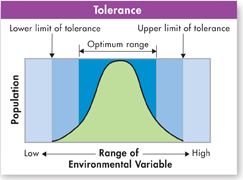4.2 Niches and Community Interactions
 What is a niche?
What is a niche? How does competition shape communities?
How does competition shape communities? How do predation and herbivory shape communities?
How do predation and herbivory shape communities? What are the three primary ways that organisms depend on each other?
What are the three primary ways that organisms depend on each other?
tolerance • habitat • niche • resource • competitive exclusion principle • predation • herbivory • keystone species • symbiosis • mutualism • parasitism • commensalism
Concept Map Use the highlighted vocabulary words to create a concept map that organizes the information in this lesson.
THINK ABOUT IT If you ask someone where an organism lives, that person might answer “on a coral reef” or “in the desert.” These answers are like saying that a person lives “in Miami” or “in Arizona.” The answer gives the environment or location. But ecologists need more information to understand fully why an organism lives where it does and how it fits into its surroundings. What else do they need to know?
The Niche
 What is a niche?
What is a niche?
Organisms occupy different places in part because each species has a range of conditions under which it can grow and reproduce. These conditions help define where and how an organism lives.
Tolerance Every species has its own range of tolerance, the ability to survive and reproduce under a range of environmental circumstances, as shown in Figure 4–4. When an environmental condition, such as temperature, extends in either direction beyond an organism's optimum range, the organism experiences stress. Why? Because it must expend more energy to maintain homeostasis, and so has less energy left for growth and reproduction. Organisms have an upper and lower limit of tolerance for every environmental factor. Beyond those limits, the organism cannot survive. A species' tolerance for environmental conditions, then, helps determine its “address” or habitat—the general place where an organism lives.

FIGURE 4–4 Tolerance This graph shows the response of a hypothetical organism to different values of a single environmental variable such as sunlight or temperature. At the center of the optimum range, organisms are likely to be most abundant. They become more rare in zones of physiological stress (medium blue), and are absent from zones of intolerance (light blue).
d
Table of Contents
- Formulas and Equations
- Applying Formulas and Equations
- Mean, Median, and Mode
- Estimation
- Using Measurements in Calculations
- Effects of Measurement Errors
- Accuracy
- Precision
- Comparing Accuracy and Precision
- Significant Figures
- Calculating With Significant Figures
- Scientific Notation
- Calculating With Scientific Notation
- Dimensional Analysis
- Applying Dimensional Analysis




